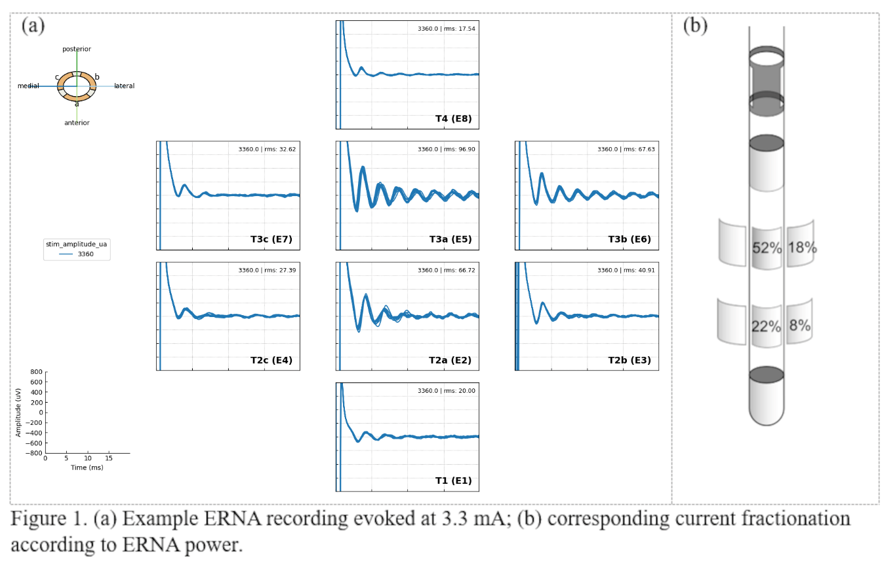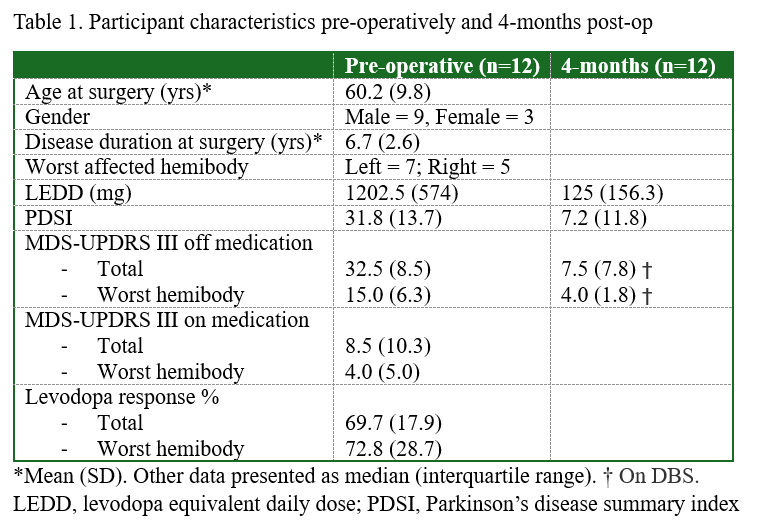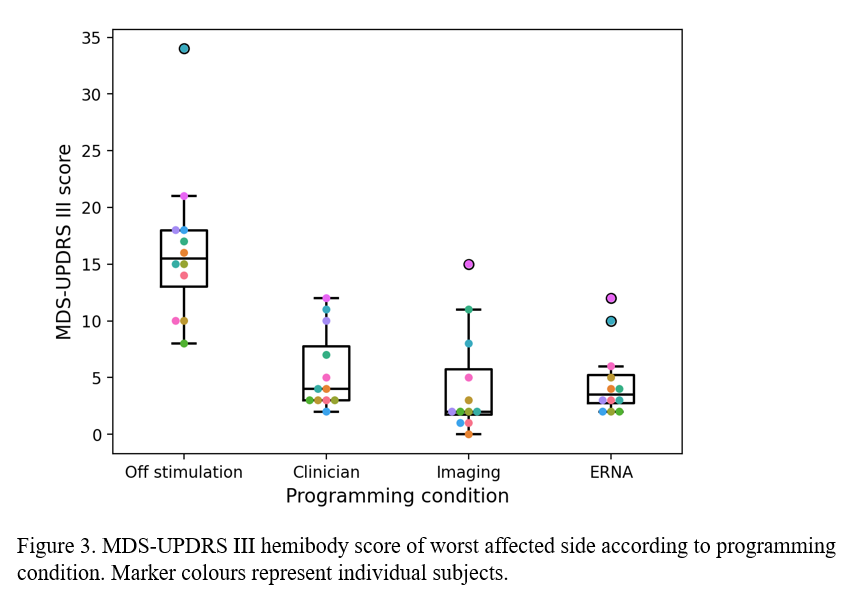Category: Surgical Therapy: Parkinson's Disease
Objective: Compare motor efficacy and tolerability of 3 methods to guide electrical field shaping of subthalamic nucleus (STN) deep brain stimulation (DBS) in Parkinsons disease (PD); clinician, imaging-guided, and evoked resonant neural activity (ERNA) derived.
Background: STN DBS efficacy in PD depends on localising stimulation to a dorsolateral ‘sweet spot’ [1]. Modern devices offer current steering and fractionation, but exploiting such capability can be time consuming and adds complexity [2,3]. Suboptimal outcomes from inexpert programming are common [4]. Using objective data may guide this process.
Method: 12 subjects implanted with bilateral STN DBS for PD completed the study [table1]. Single manufacturer DBS devices were used, capable of current steering and fractionation (configuration: 1-3-3-1). MDS-UPDRSIII was assessed off DBS > 12 hours after ceasing dopaminergic medications. In counter-balanced order, 3 programming conditions were applied double-blinded to the lead contralateral to the worst affected hemibody (mean 143 ± 21.20 days post-surgery).
Clinician : A priori standard of care heuristic-based programming
Imaging: Automated image fusion and electrode localisation. Field shaping by an expert clinician using a commercial computerised guidance system.
ERNA: Generated by computer modelling of ERNA power (ERNA evoked by 3.3 mA, as described previously) [figure1] (5).
For each condition, current was titrated as MDS-UPDRSIII subscores were measured. The frequency and pulse width employed chronically prior to the study visit were used. After determining therapeutic plateau (TP) and side effect thresholds (SET), MDS-UPDRSIII score was assessed at TP [figure2]. Friedman and post-hoc Nemenyi tests were used to assess differences in TP, SET and motor benefit.
Results: MDS-UPDRSIII hemibody scores for all 3 conditions significantly improved vs. the off-DBS, off-medication state (p<0.001) [table2; figure3] and emulated pre-operative on-medication scores (median 4.0, IQR 5.0). Acute improvement was not significantly different between ERNA and imaging (p=0.33) or clinician conditions (p=0.68). Median TP and SET were comparable across all conditions (TP: p= 0.58, SET: p=0.57).
Conclusion: ERNA-based automated field shaping of STN DBS in PD demonstrates equivalent acute motor efficacy and tolerability to existing heuristic and image-guided programming systems.
Figure1
Figure2
Table1
Table2
Figure3
References: 1. Herzog J, Fietzek U, Hamel W, Morsnowski A, Steigerwald F, Schrader B, et al. Most effective stimulation site in subthalamic deep brain stimulation for Parkinson’s disease. Mov Disord. 2004 Sep;19(9):1050–4.
2. Dembek TA, Reker P, Visser-Vandewalle V, Wirths J, Treuer H, Klehr M, et al. Directional DBS increases side-effect thresholds-A prospective, double-blind trial: Directional Dbs Increases Side-Effect Thresholds. Mov Disord. 2017 Oct;32(10):1380–8.
3. Steigerwald F, Matthies C, Volkmann J. Directional Deep Brain Stimulation. Neurotherapeutics. 2019 Jan;16(1):100–4.
4. Okun MS, Tagliati M, Pourfar M, Fernandez HH, Rodriguez RL, Alterman RL, et al. Management of Referred Deep Brain Stimulation Failures: A Retrospective Analysis From 2 Movement Disorders Centers. Arch Neurol. 2005 Aug 1;62(8):1250.
5. Xu SS, Lee WL, Perera T, Sinclair NC, Bulluss KJ, McDermott HJ, et al. Can brain signals and anatomy refine contact choice for deep brain stimulation in Parkinson’s disease? J Neurol Neurosurg Psychiatry. 2022 May 19;jnnp-2021-327708.
To cite this abstract in AMA style:
K. Nagao, T. Perera, M. Petoe, W-L. Lee, S. Xu, K. Lawson, A. Moorhead, H. Mcdermott, W. Thevathasan. Evoked Resonant Neural Activity Automates Field Shaping of Subthalamic Nucleus-Deep Brain Stimulation in Parkinson’s Disease [abstract]. Mov Disord. 2024; 39 (suppl 1). https://www.mdsabstracts.org/abstract/evoked-resonant-neural-activity-automates-field-shaping-of-subthalamic-nucleus-deep-brain-stimulation-in-parkinsons-disease/. Accessed January 5, 2026.« Back to 2024 International Congress
MDS Abstracts - https://www.mdsabstracts.org/abstract/evoked-resonant-neural-activity-automates-field-shaping-of-subthalamic-nucleus-deep-brain-stimulation-in-parkinsons-disease/





